Battle of Lone Jack facts for kids
Quick facts for kids Battle of Lone Jack |
|||||||
|---|---|---|---|---|---|---|---|
| Part of the Trans-Mississippi Theater of the American Civil War |
|||||||
 Lone Jack Battlefield |
|||||||
|
|||||||
| Belligerents | |||||||
| Commanders and leaders | |||||||
| Emory S. Foster | Vard Cockrell | ||||||
| Strength | |||||||
| 800 | 1,500–3,000 | ||||||
| Casualties and losses | |||||||
| 160 | 118 | ||||||
The Battle of Lone Jack was a fight during the American Civil War. It happened on August 15–16, 1862, in Jackson County, Missouri. This battle was part of a larger plan by the Confederates to recruit more soldiers and use guerrilla tactics in Missouri.
Contents
Why the Battle Happened
In the summer of 1862, the Confederate army needed more soldiers. They sent recruiters from Arkansas into Missouri. These recruiters included leaders like Captain Jo Shelby and Colonel Vard Cockrell. They were trying to get more people to join the Confederate side.
On August 11, a group of Confederate forces captured Independence, Missouri. This surprised the Union General John Schofield. He ordered his troops to gather and deal with this new threat.
The First Skirmish
On August 15, 1862, Union Major Emory S. Foster led about 740 soldiers from Lexington to Lone Jack. Other Union forces were on their way but would not arrive in time.
When Foster reached Lone Jack, he learned that about 1,600 Confederate soldiers were camped nearby. Foster decided to attack. Around 11:00 p.m., his men attacked the Confederate camp and scattered them. However, firing his cannon during this small fight gave away his position. It alerted other Confederate leaders like Colonel Vard Cockrell to Foster's location.
Foster's men then returned to Lone Jack to rest. Colonel Cockrell and other Confederate leaders decided to attack the smaller Union force the next morning.
The Main Battle
Colonel Cockrell planned a surprise attack for August 16. Confederate forces were supposed to hide in a field before sunrise. Then, Colonel Upton Hays would start the battle with a mounted attack from the north. The other Confederates would then launch a surprise attack from the side.
However, Hays was late. As daylight arrived, Union guards saw Hays's troops moving. This gave the Union soldiers a chance to get ready, ruining the surprise.
Even without the surprise, the Confederates attacked. The fighting was intense. Hays's forces and another group pushed back the Union soldiers on their right side. This forced them back towards their cannons. The Union soldiers operating the cannons fought bravely.
On another part of the field, Union soldiers hidden behind Osage orange trees fired at the Confederates, pushing them back for a short time. Another Confederate group, led by Colonel Hunter, ran low on ammunition and had to leave the field. This left another Confederate group, led by Jackman, exposed. Jackman's men also ran low on ammunition and pulled back.
Hays's and Tracy's Confederate groups attacked again from the north. They eventually took control of the Union cannons. But then, Union Captain Plumb counterattacked and took the cannons back. Hunter and Jackman's men returned with more ammunition. The fighting continued fiercely, with the cannons changing hands several times.
Major Foster recaptured the cannons one last time but was badly wounded in the process. After five hours of fighting, and with Foster injured, another Confederate group of 800 men arrived. Seeing this, the new Union commander, Captain Milton H. Brawner, ordered a retreat. The Union soldiers disabled their cannons and hid them before leaving.
The Confederates won the battle. However, more Union forces were approaching, so the Confederates had to leave Lone Jack on August 17. Union General Fitz Warren then occupied the town.
Some people later criticized Major Foster for attacking when he was outnumbered. They thought he should have waited for more Union troops. However, those reinforcements arrived days later.
Aftermath and Casualties
The Union commander reported that 43 Union soldiers were killed, 154 wounded, and 75 were missing or captured. This was a high number of casualties for the Union side. Confederate reports suggest that more Union soldiers were killed than first reported. The exact number of soldiers killed on both sides is not fully known.
Colonel Cockrell's men found the two Union cannons and took them back to Arkansas. These cannons were later used in other battles. The Confederate recruits also gained many needed firearms from the battle. Many of them had been unarmed before the fight.
This battle was the only Civil War battle fought by Stephen B. Elkins, who later became a very important politician. He said that the battle was "most awful" and that it made him dislike war.
Cole Younger's Role
Thomas Coleman Younger, who later became a famous outlaw, was present at Lone Jack. He was only 18 years old at the time. He rode along the front lines, helping to supply the Confederate troops.
During the battle, the wounded Union Major Foster was briefly held in a cabin. A Confederate officer who had been Foster's enemy before the war threatened him. Cole Younger stepped in and stopped the officer from harming Foster. Years later, when Younger was captured after a bank robbery, Foster, who was then a newspaper editor, spoke up for Younger and asked for mercy for him.
Images for kids




